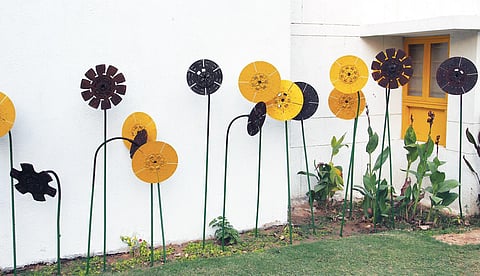

Art is responsibility. Important artistic works, from classical to surreal to abstract, have tried to truthfully communicate the ethos of their times, interpret context and leave a legacy for history. Art takes up causes and finds a political language to communicate. Its grammar is both myth and material. The Kiran Nadar Museum of Art (KNMA) has provided a platform for such dialogues of concern and conscience with the Art of Sustainability, part of ‘Art X’ digital series.
Sustainability is a growing obsession in Indian art, as India’s reckless industrialisation is laying waste to social and ecological values. Walter D’Souza, a participant in the series who at one time worked with prints, says, “Print represents the essence of sustainability in art. It democratises art since it becomes accessible to a large audience. In 1985, I began working with waste plywood, which I would get from construction sites.”
D’Souza’s use of marine ply, for example, brings to mind Subodh Kerkar’s Museum of Goa. Like Kerkar’s installations made from foraged and discarded materials reflect the ocean and its human depredations, D’Souza too recycles and re-imagines plywood to add an additional layer to his vision. The process and end result exemplify the role of art in highlighting environmental values.
The series spans ecological issues across creative disciplines represented by both Indian and global personalities in art, fashion, architecture and design. The purpose is to address the issue that what and how we consume impacts our living spaces, both physical and psychological. Leading Korean pop artist Choi Jeong Hwa’s medium is recycled material such as old publicity banners and commercial plastic containers. Likewise, US Chinese artist Cui Fei uses foraged vines, twigs and tendrils. American Chris Maynard uses bird plumage in his work.
Shakuntala Kulkarni, a participant in the series, is a proponent of sustainability. For the show, she has used cane in her artwork to display its organic value and versatility. In her business, she collaborates with local artisans. The oral history of communities and products interests her as a larger narrative of sustainability. Participants such as other fashionistas, designers, actors, artists, gallerists and journalists—Bandana Tewari, Varun Rana, Atul Bhalla, Roma Narsinghani, Rina Singh, Roshni Vadehra, Sahar Mansoor, Dia Mirza and Pragya Kapoor—promise to turn the series into a tour de force of the sustainability movement.
In a larger context, sustainability is intertwined with the work of a museum, everpresent as an idea while curating collections and exhibitions. Says Kiran Nadar, chairperson, KNMA, “Sustainability is important as we look to preserve our planet. Every small step makes a difference.” Art is meant for perpetuity, as a living record of civilisation for future generations to enjoy, experience and gain knowledge from. It is essential to preserve any collection beyond a lifetime. While the event ends on August 8, it will be available on all social media platforms of KNMA and can be viewed on their official website.
Art is meant for perpetuity, as a living record of civilisation for future generations to enjoy, experience and gain knowledge from